Diminazene aceturate modified nanocomposite for improved efficacy in acute trypanosome infection
Oluwatosin Kudirat Shittu, Shaba Yisa Aaron, Mariam Damilola Oladuntoye, Bashir Lawal
Department of Biochemistry, Tropical Disease/ Nanotechnology Research Unit, Federal University of Technology, P.M.B. 65, Minna, Nigeria
1. Introduction
Drug deliveries have become important tools in the medical field due to the strong demand for the controlled delivery of pharmacologically active materials to cells, tissue, and organs. Many drug-delivery methods have been developed using polymers as drug carriers which can effectively deliver the drug to a target site and thus increase the therapeutic benefit, while minimizing side effects [1]. Because of the flexibility of polymers, it has become possible to engineer multiple functionalities required for efficient drug delivery, simultaneously maintaining biocompatibility, facile manufacturing, and stable formulation. Some of the traditionally used polymers like silicone have been suspected to cause cancer, therefore, there is a need for nontoxic, biodegradable, and biocompatible polymers.
However, one of the alternatives to conventional polymers is biodegradable biopolymer. Among the various biodegradable polymers, there is growing interest in the group of biopolymers known as polyhydroxyalkanoates (PHAs). Polyhydroxyalkanoate(PHA) is a polyesters class that is non-toxic, bio-derived and biodegradable. Polyhydroxybutyrateis one class of PHA that are insoluble in polar solvent, hence, relatively resistant to hydrolytic degradation. This differentiates PHB from most other biodegradable polymers, which are either water soluble or moisture sensitive. They have good oxygen permeability, ultra-violet resistance but poor resistance to acids and bases, biocompatible and hence are suitable for medical applications[2]. All these makes it a potentially good material for medical application (as bone plates, surgical sutures and blood vessel replacements), in the pharmaceutical and food industries, as biodegradable carriers for the long-term dosage of drugs, medicines, hormones, insecticides and herbicides [3].
African trypanosomiasis is one of the neglected diseases of sub-Sahara Africa that have impact of both human health and economic development of the affected areas [4]. The fight against the disease has relied mainly on vector control system and chemotherapies. However, the effectiveness and safety remains a source of concern due to the side effect associated with the drugs[5]. Diminazeneaceturate is a trypanocide used to treat animal trypanosomiasis, this drug has beenassociated with poor efficacy,limited solubility and major side effects[5] due to non-specificity of the drug on the target site.
The use ofemerging Nanotechnology such asgoldnanoparticles(AuNP) in area of medical applications especially as a drug carrier for targeted drug delivery has the advantage of bioavailability,in vivo stability, intestinal absorption, solubility, sustained and targeted delivery, and therapeutic effectiveness of several anticancer drugs(ref). Also, polymeric nanoparticles either synthetic or natural may act as efficient systems for drug release studies as these possess the property of biodegradability, biocompatibility andbiostable [6].Due to these properties, they can overcome various barriers and target to the cancer cells without any harm to normal cells and tissues. Poly hydroxyl butyric acid (PHB) has also been used as a suitable nanoparticle for its biodegradability and biocompatibility in biomedical applications [7]. Therefore, this study is aim at synthesized gold nanoparticle functionalized with naturally synthesized polyhydroxybutyratefrom mango and orange seeds as a nanocarrier for diminazeneaceturate used for the treatment of animal trypanosome.
2. Materials and methods
2.1. Materials
2.1.1. Plant sample
Fresh leaves of hyptissuaveolens were obtained from Minna,Niger State Nigeria. Taxonomic authentications of the plants were carried out by Botanist at the Department of Biological science,Federal University of Technology, Minna. Nigeria. The leaves were destalked, washed with clean-water, dried at room temperature and finally grounded using a grinder mill.
2.1.2 . Experimental animals
Healthy albino rats of average weight 120-150 g were purchased from small animal holding unit, Federal University of Technology,Minna, Niger State Nigeria. The rats were maintained under standard laboratory conditions with unrestricted access to rat pellets and water ad-libitum. The study was carried out per the Guide for the Care and the Use of Laboratory Animals of the Institute of Laboratory Animal Resources, Commission of Life Sciences, National Research Council, USA[8].
2.1.3. Reagent and assay kits
The gold chloride (HAuCl4) was a product of Sigma Aldrich. The assay kits for AST, ALT, ALP and total protein were products of Randox Laboratories Ltd, United Kingdom. All other reagents used were of analytical grade and were prepared in distilled water.
2.2. Methods
2.2.1. Parasite strain
The parasite Trypanosomabrucei brucei (T. brucei brucei)was obtained from the Nigeria Institute for trypanosomiasis research(NITR) Vom Jos, Plateau State. The Parasite was maintained in the laboratory by serial blood passage into normal albino Rats until required.
2.2.2. Synthesis and characterization of gold nanoparticles
The synthesis and characterization of gold nanoparticles were as previously reported[9]. Briefly, one hundred milliliters of distilled water were added to 5 g of milled plant in an Erlenmeyer flask and then boiled for 5mins after which it was filtered, and then 0.5 mL of the plant extract was added to 9.5 mL of 1mM aqueous HAuCl4solution for the reduction of Au3+ ions. The synthesize gold nanoparticles were characterized with UV-VIS Spectrophotometer(UV-1800 Shimadzu).
2.2.3. Production and extraction of polyhydroxyalkanoate(PHA)
The production and extraction of PHA was as previously reported[10]. Briefly Production of PHA was carried out in a two-stage fermentation process. In the first production stage, primary inoculum was prepared by culturing Bacillus megateriumin 100 ml of sterilized nutrient broth, at 37°℃in an incubator shaker (New Brunswick Scientific, Innova 44) with a regulated speed of 120 revolutions per minute (rpm) for 24 h. In the second stage, 2 mL of the 24 h culture wasintroduced in to 100 ml of two sterilized nutrient deficient media (pH 7.0). The cultures were then incubated at 37°℃ in a shaker (New Brunswick Scientific, Innova 44) at 120 rpm for 48 h.Extraction and quantification was done per the methods described in[11]with slight modifications.
2.2.4. Functionalization of gold nanoparticle
The functionalization of the gold nanoparticle was carried out using poly hydroxyl butyrate synthesized from orange and mango seed kernel as a nanocarrier.
2.2.5. Drug conjugation and release
Diminazeneaceturate was added to polyhydroxybutyrate (PHB)functionalized gold nanoparticle in aqueous phase and stirred for 30 minutes at room temperature [12]. All the formulations were made in to tablet form and left for 24 hours at room temperature to enable digestion of the mixture, and properly air dried. The tablets were assessed in deionized water based on in vitro dissolution method for 3 and 6 minutes (O-PHB), and 15 and 30 minutes of M-PHB). The absorbance of each solution was determined spectrophotometrically.
2.2.6. In vivo antitrypanosomal analysis
A total of thirty (30) albino rats were group into 6 (A-F) of 5 rats each & infected intraperitoneally with 0.2ml of the inoculum containing about 1×103T. brucei bruceiparasites per 0.2 mL of blood. Infection was monitored after 72 hours for the appearance of parasites in the newly infected animals [13]. Groups A and B were treated with 3 and 6 minutes released orange PHB, Groups C and D were treated with 15 and 30 minutes released mango PHB formulated tablet while Groups E and F were negative (untreated)and standard drug (DininazeneAceturare) respectively. Parasite count was done on daily basis per the method described by Ekanem &Yusuf[14]. The procedures described by Akanji et al.[15] were adopted for collection & preparation of serum and tissue homogenates.
2.2.7. Determination of biochemical & hematological parameters
The biochemical analyses were determined for alkaline phosphatase (ALP) based on methods of Tietz [16], Aspartate transaminase (AST) and alanine transaminase (ALT) as described previously [17]. The total protein concentration was estimated by biuret method as described by Sulaiman and Adeyemi [18], while catalase was estimated as described[19]. The Sysmex Haematology Systems (SysmexAmerica Inc., model no. KX-21N, Kobe, Japan)was used to determine the levels of haemoglobin (Hb), packed cell volume (PCV), red blood cells (RBC), mean corpuscular volume(MCV), mean corpuscular haemoglobin (MCH), mean corpuscular haemoglobin concentration (MCHC), white blood cells (WBC),neutrophils, lymphocytes and platelets [20].
2.2.8. Statistical analysis
Data analyses were performed using SPSS software (SPSS 10.0 for Windows, SPSS Inc, Chicago, IL). All data are expressed as mean ±SEM. Analysis of variance (ANOVA) was used to test for differences between the groups. Duncan’s multiple range tests was used to determine the significance of differences among the mean values at the level ofP<0.05 [21].
2.3. Ethical approval
The principles governing the use of laboratory animals as laid out by the Federal University of Technology, Minna Committee on Ethics for Medical and Scientific Research and alsoexisting internationally accepted principles for laboratory animal use and care as contained in the Canadian Council on Animal Care Guidelines and Protocol Review were duly observed.
3. Results
3.1. Characteristic of Biosynthesis of gold nanoparticles
The biosynthesized gold nanoparticle of aqueous leaf extract of Hyptissuaveolens had a characteristic brownish colour. UV-Visible spectrophotometric scanning showed that the biosynthesized gold nanoparticle had absorption peak of 535 nm (Figure 1). The Zetasizer measurement showed the average particle size of 28.5 nm with the intensity of 17.5%. TEM images showed shape to be spherical hexagonal and triangular at 50 nm. Energy-Dispersive Spectroscopy Analysis confirmed the presence of gold and other elements (carbon,copper and oxygen). The maximum optical adsorption peak was observed at approximately 2.30 keV and addition signals for carbon at 0.20, oxygen 0.50 and copper 8.30. The FTIR spectra reveals a strong band in functional group region at 3448.84 cm-1 and this strong band region corresponds to the hydroxyl group and the finger print region at 1643.41 cm-1corresponds to the alkene (C=C) and carbonyl (C=O) group.
3.2. Antitrypanosomal
The parasitaemia of infected untreated group increased infinitely while infected rat treated with orange based polyhydroxy butyrate nanodrug at 3 and 6 minute –treated group shows a decrease in the proliferation and complete parasite clearance on day 7 (Figure 2). Although rat treated with mango based polyhydroxy butyrate nanodrug at 15 and 30 minutes shows low replication of parasite compared with the untreated rats there was also a progressive increase in parasite count.
3.3. Biochemical parameters
The ALP and ALT activities were significantly lowered (P< 0.005)in serum and liver of rat treated with 3 and 6M O-PHB compared with the rats treated with free drugs and the untreated control. The serum AST in infected un-treated rats were significantly lowered(P<0.05) than all treated rats. However, serum AST activities in rat treated with O-PHB compared well with that of the rats treated with free drug. However, no significant (P<0.05) difference were observed in serum total proteins among the experimental groups(Figure 3).
The liver AST activities were significantly (P<0.05) higher in rats treated with 15 and 30-minute M-PHB than those treated with the free-drug and the untreated control. However, serum AST activities in infected-untreated rats were significantly (P<0.05) higher than all treated groups. The liver ALT activities in infected-untreated rats were significantly (P<0.05) higher than all treated groups. ALP activities were significantly (P<0.05) raised in liver and serum of rat treated with 15 and 30 minutes released of functionalized mango PHB when compared with the infected untreated controls.The liver total proteins in rats treated with 15 minutes released of functionalized M-PHB was significantly (P<0.05) higher than the controls (untreated and free-drug). However, no significant (P>0.05)differences were observed in serum total proteins and serum ALT activities in rats treated with 15 and 30 minutes released of functionalized M-PHB compared with the controls (untreated and free-drug) (Figure 4).
The serum and liver catalase activities in infected untreated rats were significantly (P< 0.05) higher than all treated groups. However,there were significant decrease (P< 0.05) in serum and liver catalase activities in rats treated with 3 and 6 minutes O-PHB compared with those treated with free-drug (Figure 5).
3.4. Hematological Parameters
Table 1 shows the level of haematological components inT. brucei bruceiinfected rats treated with diminazeneaceturate (freed rug)andorange - polyhydydroxy butyrate functionalize drug (M-PHB).There were significant increases (P<0.05) in the values of Hb,MCHC, PCV, RBC, and WBC in T. brucei infected rats treated with free drug andO-PHB when compared with untreated rats. However,except for the increase in WBC count in rats treated with 6 minutes O-PHB, the haematoalogical parameters compared well (P>0.05)between rats treated with free drug andO-PHB functionalize drug.Similarly, there were significant increases (P<0.05) in the values of Hb, MCHC, MCV, MCH, PCV, RBC, and WBC inT. brucei bruceiinfected rat treated with free drug andM-PHB when compared with untreated rats. However, RBC counts in rats treated with M-PHB (15 and 30-minute release) were significantly lowered while WBC count was significantly raised when compared with rats treated with free drug.
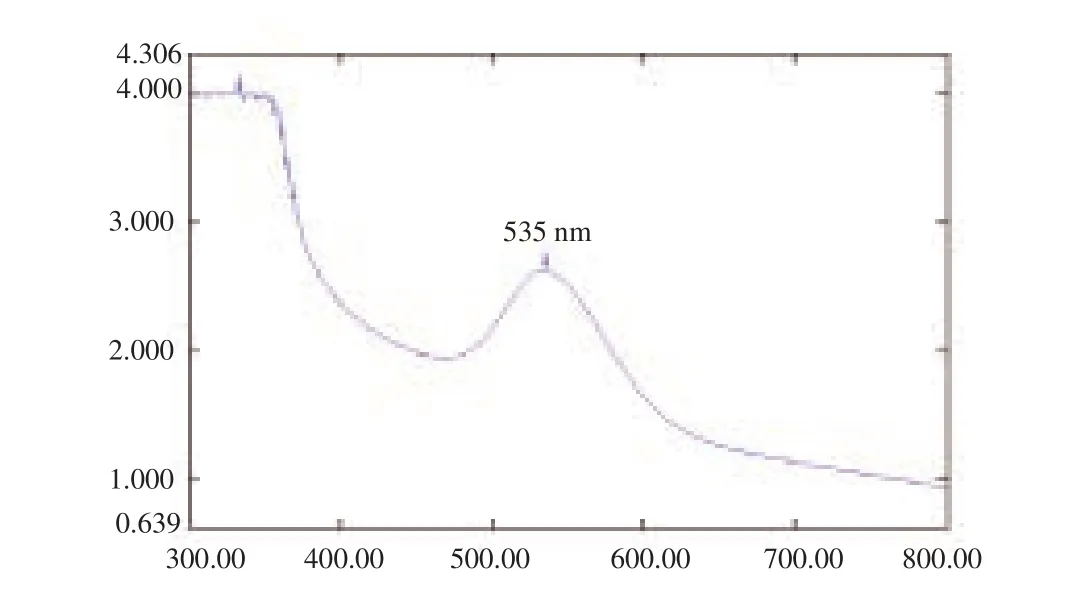
Figure 1. Absorption peak of biosynthesized gold nanoparticle, showing absorption peak at 535 nm.
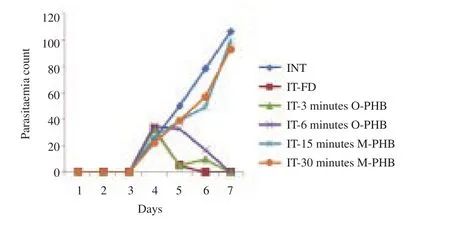
Figure 2. Parasite count of T. brucei brucei infected rat treated with orange based polyhydydroxy butyrate nanodrug.Each point is an average count from five infected rats.

Table 1Haematological components in T. brucei infected rats treated with orange- and mango- polyhydydroxy butyrate functionalize diminazeneaceturate.
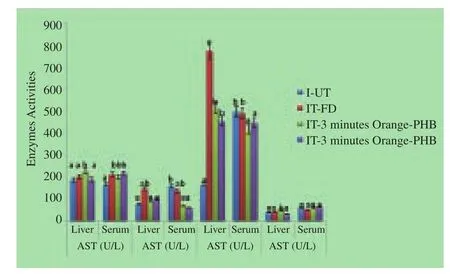
Figure 3. Serum and liver biochemical parameters in rats treated with O-PHB Nano-formulated.Each bars represents mean ± SEM of five determinations. Bars with different superscript alphabet are significantly different (P<0.05).
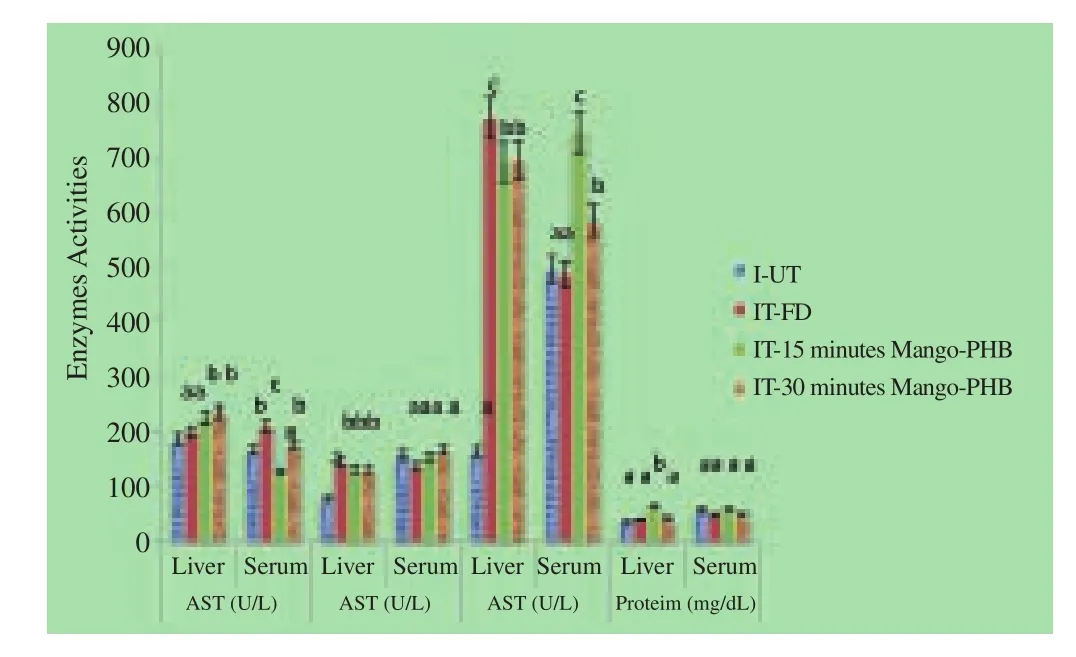
Figure 4. Serum and liver biochemical parameters in rats treated with M-PHB Nano-formulated.Each bars represents mean ± SEM of five determinations. Bars with different superscript alphabet are significantly different (P<0.05).
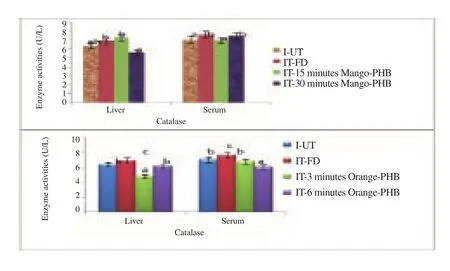
Figure 5. serum and liver catalase activities in rats treated with Nanoformulated.Each bars represents mean ± SEM of five determinations. Bars with different superscript alphabet are significantly different (P<0.05).
4. Discussion
The development of new therapeutic or improving existing ones against trypanosomes is an important subject and it has been a subject of some recent investigations, mainly due to the shortcoming of the available therapy [22]. Nanotechnology is a powerful tool that can be used to reduce the toxic side effect of drug therapy.
In this study, free diminazeneaceturate and the PHB-Nano formulateddiminazeneaceturate were evaluated for comparative antitrypanosomal activities in order to determine whether conjugating drugs to surface PHB- nanoparticles could optimize drug delivery to target site while minimizing collateral damage. The parasitaemia count obtained from treatment with diminazeneaceturate showed the drug produce satisfactory efficiency in clearing the parasite from circulation, however, the unwanted deleterious effect of this drug is our major concern. The delayed in parasite clearance to day 7 post infection following treatment with O- PHB Nano formulated drug does not translate to reduced efficacy of the drug by Nano encapsulation but, rather, indicate gradual release of the drug from the formulation into the target site. This is an essential mechanism used by nanoparticles to improving efficacy and reduced toxicity of the encapsulated drug.
The liver is known to play vital role in intermediary metabolism of biomolecules and its cellular integrity can be altered by toxic side effect of drugs, chemicalsand related disease [23]. Evaluation of biochemical indices in the liver and serum are useful ‘markers’for assessing clinical symptoms and tissue damages produce by drug or toxicant [24]. Alkaline phosphatases are often used to assess the integrity of plasma membrane and endoplasmic reticulum AST and ALT are liver based enzymes that catalyze transamination reaction[25]. However, high activities of these enzyme in serum occur during liver damage when there are leakages from their based into blood circulation. These enzymes therefore provide significant information about the integrity of liver.In the present study, the treatment of rats with diminazeneaceturate significantly raised the levels of ALP and ALT enzyme in rats. Such elevation in the enzymesactivities willadversely affect the metabolism ofamino acid and carbohydrate with consequent effect on ATP generation[26].Interesting, the treatment of rats with 3 and 6 minutes O-PHB Nano formulated drug decreased the elevated levels of ALP and ALT enzyme significantly. In contrast, AST andALP levels significantly increased in treated with 15 and 30 minutes M-PHB when compared with those treated with free drug. This finding shows that PHB synthesize from orange seed improved efficacy and reduced toxicity of diminazeneaceturate, than thePHB synthesize from mango seed.According to Yang et al., [27], liver is one of the frequent target organs and a central site of accumulation of nanoparticles, thus the alterations to the levels of enzymes recorded in this may represent adaptive mechanisms by the animals to offset stress induced by exposure to the M-PHB Nano formulated drug. Total protein is composed of albumin and globulin and play important roles in determining the synthetic and excretory roles of the liver and kidney[13]. The significant decrease in total protein in rats treated with M-PHB Nano formulated drug could be as a results of increased anabolism, decreased catabolism or malabsorption by the liver as an adaptive mechanism to overcome the stress imposed by the M-PHB Nano formulated drug. Previous study [28] has demonstrated that administration of drugs or chemical agents could enhance protein synthesis de novo as part of adaptive mechanisms.
High level of catalase activities has been reported to correlate with severity of oxidative stress during trypanosome infection[29]. The results of the effect of the Nano formulation on catalase activities showed that the rat treated with O-PHB Nano formulated drug had lower catalase activities than those treated with the free drug and the untreated rats. This is an indication that O-PHB Nano formulated drug exert more therapeutic efficiency in alleviating the trypanosomes-induced free radical’s generation. However,this efficiency was not demonstrated by mango based-PHB Nano formulated drug.
Hematological indices generally provide information on the deleterious effects of trypanosome infection and productive performance of the infected animals [18]. The significant decreases in the values of Hb, MCHC, PCV, RBC, and WBC count in T.brucei bruceiinfected untreated rat is an indication of anemic condition [30].This finding agrees with study of Ekanem et al.[31], who reported that trypanosome infection cause anemia as a result of massive erythrophagocytosis by an expanded and active mononuclear phagocytic system (MPS) of the host. It has also been established that trypanosomes infection result in depletion of reduced glutathione on the surface of the red blood cell they’re by increasing the susceptibility of red blood cell membrane to oxidative damage [29].These hematological parameters compared well between rats treated with free drug and O-PHB functionalize drug. However, contrary to the report of [18], the present study showed that administration of free diminazeneaceturate does not modulate the state of anemia and immunosuppressive conditions in trypanosome infected rats
In contrast, RBC counts in rats treated with M-PHB were significantly lowered while WBC counts were significantly raised when compared with rats treated with free drug (Table 1).WBCs are known for their defensive role against foreign substances and infectious agentsthrough the production, transportation and distribution of antibodiesin immune response [32]. The significant increased WBC counts following treatments with M-PHB reflect leucopoetin-release and possible immunomodulatory effects of the nanoparticle which augmented the production of WBC to overcome the stress induced by the constituent of the Nano formulation. This will enhance the capabilityof generating phagocytes and antibodies against the recognizable antigens from subsequent challenge [33,34].
Conclusion
Hyptis suaveolens plant shows the ability to reduce gold chloride to gold nanoparticle which confirms the potential value of the plant in nanoparticle synthesis. Noteworthy, this study has demonstrated the fact that orange based polyhydroxy butyrate modified gold nanoparticles could be exploited for drug delivery and/or used tomodulate toxic virtues of diminazeneaceturate. However, the increase toxicity demonstrated by orange based polyhydroxy butyrate Nano formulation called for thorough screening of natural products for use as a carbon source in the synthesis of polyhydroxy butyrate for effective drug delivery
Conflict of interest statement
The authors declared no conflict of interest exist
Acknowledgement
This research was supported by Tertiary Educational Trust Fund of Nigerian (TETFUND) Institutional—Based Research Intervention of Federal University of Technology, Minna (TETFUND/FUTMINNA)/2014/42).
[1] Anupama S, Hae-Yeong K, Young-Rok K. Advances in the applications of polyhydroxyalkanoate nanoparticles for novel drug delivery system.Bio Med Res Int2013, Article ID 581684, 12 pages.Doi:10.1155/2013/581684.
[2] Bugnicourt E, Cinelli P, Lazzeri A, Alvarez V. Polyhydroxyalkanoate(PHA): Review of synthesis, characteristics, processing and potential applications in packaging.Express Polym Lett2014; 8(11): 791–808.
[3] Lee SY. Bacterial polyhydroxy-alkonates.Biotechnol & Bioeng1996;49:1-14.
[4] Bashir L, Shittu OK, Sani S, Busari MB, Adeniyi KA. African natural products with potential antitrypanosoma properties: A review.Int J Biochem Res & Rev2015;7(2): 45-79.
[5] WHO (World Health Organization).Human African trypanosomiasis(Sleeping sickness). Fact Sheet No. 259. Gevena; WHO; 2012.
[6] Cesare E, Cristina B, Federica C, Emo C. Poly(hydroxyalkanoates)-based polymeric nanoparticles for drug delivery.J Biomed & Biotechnol2009, Article ID 571702, 10 pagesdoi:10.1155/2009/571702
[7] Sasikumar P, Ayyasamy PM. Design and characterization of polyhydroxy butyric acid (PHB) based polymeric nanoparticles for controlled release of doxorubicin for cancer treatment.Int J Curr Microbiol App Sci2015; 4(12): 311-317.
[8] Institute of Laboratory Animal Resources, Commission on Life Sciences,National Research Council.Occupational health and safety in the care and use of research animals. Washington: National Academy Press;1997.
[9] Singh M, Kalaivani R, Manikandan S. Facile green synthesis of the variable metallic gold nanoparticle using padinagymnospora, a brown marine macroalga.Appl Nanosci2013; 3:145–151.
[10] Nasir-Naeem KO, Shittu OK, Kabiru AY. Production and characterization of polyhydroxyalkanoate (PHA) using mango seed kernel as an alternative to glucose.Bri Biotechnol J2016;13(3): 1-11.
[11] Tian F, Zhao YL, Liu CJ, Li F, Xing N. The vitro and vivo study of Poly(3-hydroxybutyrate) microspheres. 7th Asian-pacific conference on medical and biological engineering.IFMBE Proceedings2008; 19: 615-622.
[12] Adeyemi OS, Sulaiman FA. Evaluation of metal nanoparticles for drug delivery systems.The J Biomed Res2015;29(2):145-149.
[13] Shittu OK, Elekwechi U, Musa BB, Lawal B. Antitrypanosomal activities and Effect of ethyl acetate extract of honey bee (Apis Mellifera)on haematological parameters ofTrypanosoma brucei bruceiinfected rats.J Adv Biol & Biotechonol2015;3(1): 29-35.
[14] Ekanem JT, Yusuf OK. Some biochemical and haematological effects of black seed (Nigella sativa) oil on T. brucei-infected rats.Afr J Biomed Res2008; 11: 79-85.
[15] Akanji MA, Salau AK, Yakubu MT. Safety evaluation of aqueous extract of Cratevaadansonii leaves on selected tissues of rats.Fount J Nat Appl Sci2013; 2(1): 17-28.
[16] Tietz NW.Clinical guide to laboratory tests. 3rd ed. Philadelphia: WB Saunders Company; 1995, p. 286-288.
[17] Ekanem JT, Yusuf OK. Activities of alkaline phosphatase, glutamate oxaloacetate transaminase and glutamate pyruvate transaminase in liver and serum ofTrypanosoma brucei-infected rats treated with honey.Biokemistri2005;17:185-191.
[18] Sulaiman FA, Adeyemi OS. Changes in haematologica indices and protein concentrations in trypanosomabruceiinfected rats treated with homidium chloride and diminazeneaceturate.EXCLI J2010; 9:39-45.
[19] Shittu OK, Lawal B, Oluyomi OI. Effects of methanol extract of Musca domestica larvae on antioxidants enzymes inT. brucei bruceiinfected rats.Niger J Biochem Mol Biol2014; 29(2): 1-10.
[20] Berinyuy EB, Lawal B, Olalekan AA, Olalekan IA, Yusuf AA, Sakpe S,et al. Hematological status and organs/body-weight parameters in Wister rats during chronic administration ofCassia occidentalis.Int Blood Res Rev2015; 4(3): 1-7.
[21] Yalta AT. The accuracy of statistical distributions in Microsoft® excel 2007.Comput Stat Data Anal2008; 52:4579-4586.
[22] Yusuf AB, Umar IA, Nok AJ. Effects of methanol extract of Vernoniaamygdalinaleaf on survival and some biochemical parameters in acute Trypanosoma bruceibruceiinfection.Afr J Biochem Res2012;6(12):150-158.
[23] Lawal B, Shittu OK, Ossai PC, Abubakar AN, Ibrahim AM. Evaluation of antioxidant activity of giant African snail (Achachatinamaginata)haemolymph in CCl4-induced hepatotoxixity in albino rats.Br J Pharm Res2015; 6(3): 141-54.
[24] Yusuf OK, Bewaji CO, Ekanem JT. Biochemical evaluation of fermented wheat germ and on Trypanosoma brucei-infected rats.Afri J Biomed Res2010; 13: 219-224.
[25] Shittu OK, Musa F, Gbadamosi DF. Trypanocidal activity and heamatological changes in T. bruceiinfected rats treated with methanolic leaf extract of Thymus vulgaris.Int J Appl Biol Res2013;5:109 – 114.
[26] Shittu OK, Lawal B, Alozieuwa BU, Haruna GM, Abubakar AN,Berinyuy EB. Alteration in biochemical indices following chronic administration of methanolic extract of Nigeria bee propolis in Wister rats.Asian Pac J Trop Dis2015; 5(8): 654-657.
[27] Yang S, Wang X, Jia G. Long-term accumulation and low toxicity of single-walled carbon nanotubes in intravenously exposed mice.Toxicol Lett2008; 181(3): 182–189.
[28] Sulaiman FA, Adeyemi OS, Akanji MA, Oloyede HO, SulaimancAA,Olatunde A. et al., Biochemical and morphological alterations caused by silver nanoparticles in Wistar rats.J Acute Med2015; 5:96-102
[29] Akanji MA, Adeyemi OS, Oguntoye SO, Sulyman F. Psidiumguajava extract reduces trypanosomosis associated lipid peroxidation and raises glutathione concentrations in infected animals.EXCLI J2009;8:148-154.
[30] Bashir L, Shittu OK, Busari MB, Sani S, Aisha MI. Safety evaluation of giant African land snails (Archachatinamarginata) haemolymph on Hematological and Biochemical Parameters of Albino Rats.J Adv Med Pharm Sci2015;3(3):122-130.
[31] Ekanem JT, Kolawole OM, Abbah OC. Trypanocidal potential of methanolic extract of Bridelia ferrugineabenth bark inRattus novergicus.Afr J Biochem Res2008; 2:45-50.
[32] Lawal B, Shittu OK, Abubakar AN, Haruna GM, Saidu S, Ossai PC.Haematopoetic effect of methanol extract of Nigerian honey bee(Apismellifera) propolis in mice.J Coast Life Med2015; 3(8): 648-651.
[33] Lawal B, Shittu OK, Rotimi AA, Olalekan IA, Kamooru AA, Ossai PC.Effect of methanol extract of Telfairiaocccidentalis on haematological parameters in Wister rats.J Med Sci2015; 15(5): 246-250.
[34] Lawal B, Shittu OK, Oibiokpa IF, Mohammed H, Umar SI, Haruna GM.Antimicrobial evaluation, acute and sub-acute toxicity studies ofAllium sativum.J Acute Dis2016; 5(4): 296–301.
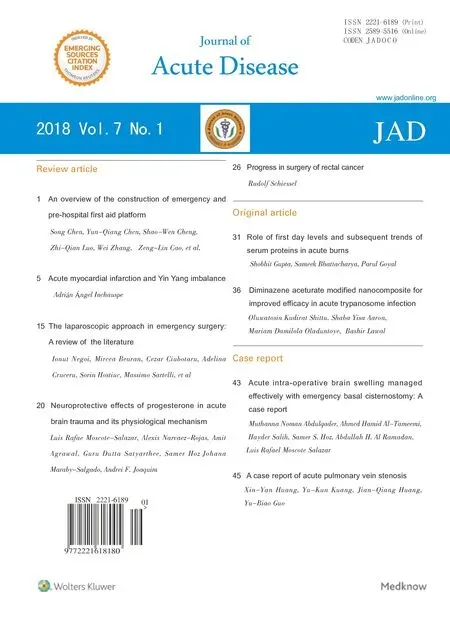 Journal of Acute Disease2018年1期
Journal of Acute Disease2018年1期
- Journal of Acute Disease的其它文章
- A case report of acute pulmonary vein stenosis
- Acute intra-operative brain swelling managed effectively with emergency basal cisternostomy: A case report
- Role of first day levels and subsequent trends of serum proteins in acute burns
- Progress in the surgery of rectal cancer
- The laparoscopic approach in emergency surgery: A review of the literature
- Acute myocardial infarction and Yin Yang imbalance
